We all know that trees are vital to our environment. Photosynthesis is a process in which plants and trees use sunlight to synthesize nutrients from carbon dioxide and water. Oxygen is then produced, which is a byproduct essential to humankind.
The question is, do all trees produce the same amount of oxygen? The short answer is that specific kinds of trees produce more oxygen than others. The oxygen production of trees depends on the overall leaf mass or the Leaf Area Index.

In this article, we list the 5 trees that produce the most oxygen. We will also tackle some of the most common questions about the oxygen production of trees, including the factors that affect their production and if trees produce oxygen at night.
Table of Contents
5 Trees That Produce the Most Oxygen
1. Beech
Beech, also known as Fagus, is a genus of deciduous trees belonging to the Fagaceae family. Native to temperate Europe, North America, and Asia, this tree is distinguished by its smooth, gray bark. There exist thirteen species of beech trees, with the European beech as the most widely known.
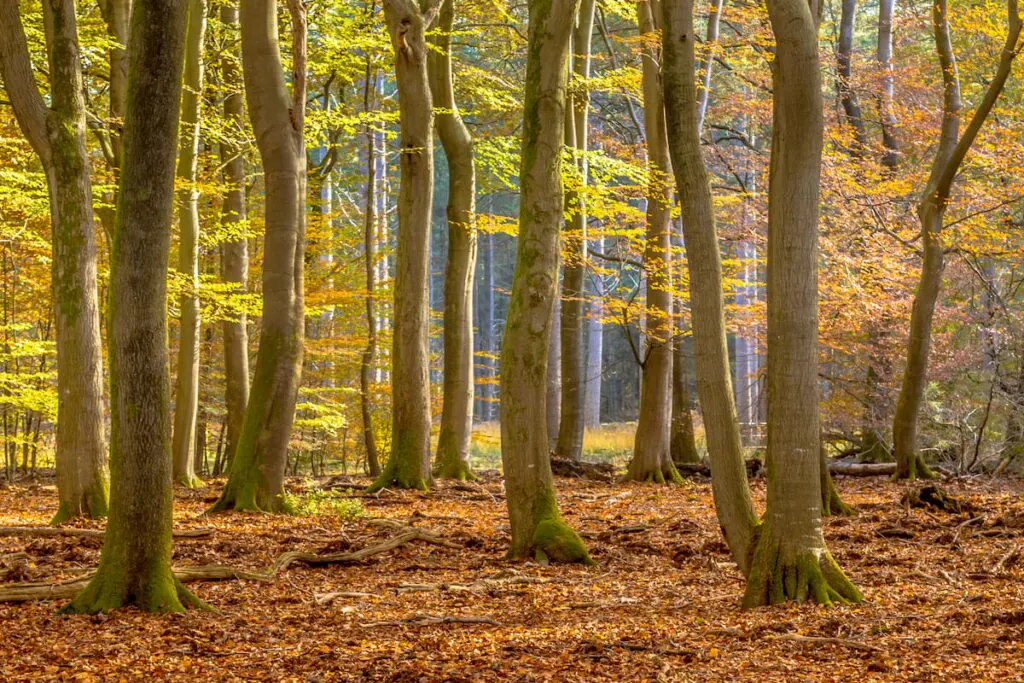
Beech leaves are oval-shaped and may or may not have a pointed end. They range from 2 to 6 inches (5 to 15 cm) long and 2 to 4 inches (4 to 10 cm) wide with either toothed or wavy edges depending upon the species. During fall, their leaves turn yellow, orange, or brown and may persist through the winter on young trees.
These trees produce tiny, insignificant flowers in spring. Beech trees are monoecious, which means that they will produce both male and female flowers on the same tree. Small, tiny male flowers grow along the branches, while the red, female ones grow at the end of the branches.
Beech thrives in various soil types so long as they are not waterlogged. These trees are usually found in USDA zones 3 to 9. They also have a high Leaf Area Index (LAI) which enables them to produce a great deal of oxygen. On average, Beech trees produce about 260 pounds of oxygen in a year.
2. Douglas Fir
Douglas Fir (Pseudotsuga menziesii), also known as red fir, Oregon pine, and Columbian pine, is a medium to large tree that ranges from 70 to 330 ft (20 to 100 m) tall. Despite its name, Douglas Fir is not a true fir, nor is it a pine or spruce. It is an evergreen tree that is native to western North America.
Douglas Fir comes in two varieties: the coastal and the Rocky Mountain varieties. While both varieties are evergreen, the coastal variety grows taller and faster. In general, these trees can live for upwards of 500 years!
Douglas Firs have linear needle-like leaves that are .75 to 1.5 inches (2 to 4 cm) in size. As evergreen trees, they can photosynthesize even in winter, thus enabling them to produce oxygen year-round.
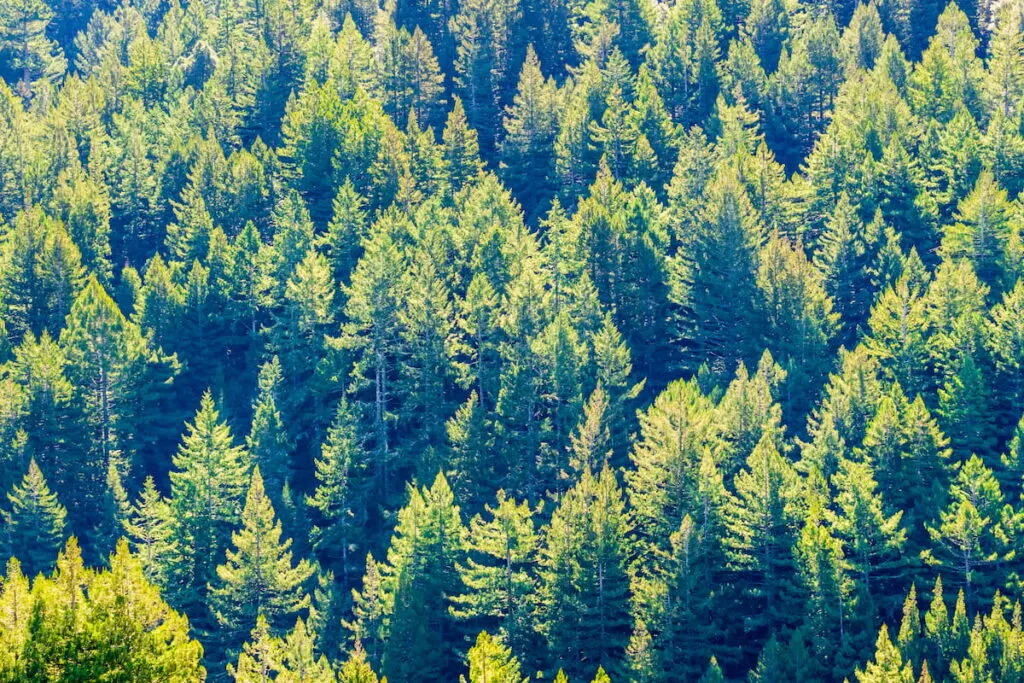
Not only are they a good source of oxygen, but the seeds of Douglas Fir make an essential food source for squirrels and other small mammals. They also have sturdy wood, which is why they are used as timber for construction.
Douglas Firs grow best in USDA plant hardiness zones 4 through 6. Plant them in a shadier area in soil with good moisture retention and good drainage to ensure that they grow well.
3. Maple Tree
Maple, scientifically known as Acer, is a genus of trees and shrubs with about 132 species which are primarily found in Asia. However, other species exist in Northern Africa, North America, Europe, and one in the Southern Hemisphere.
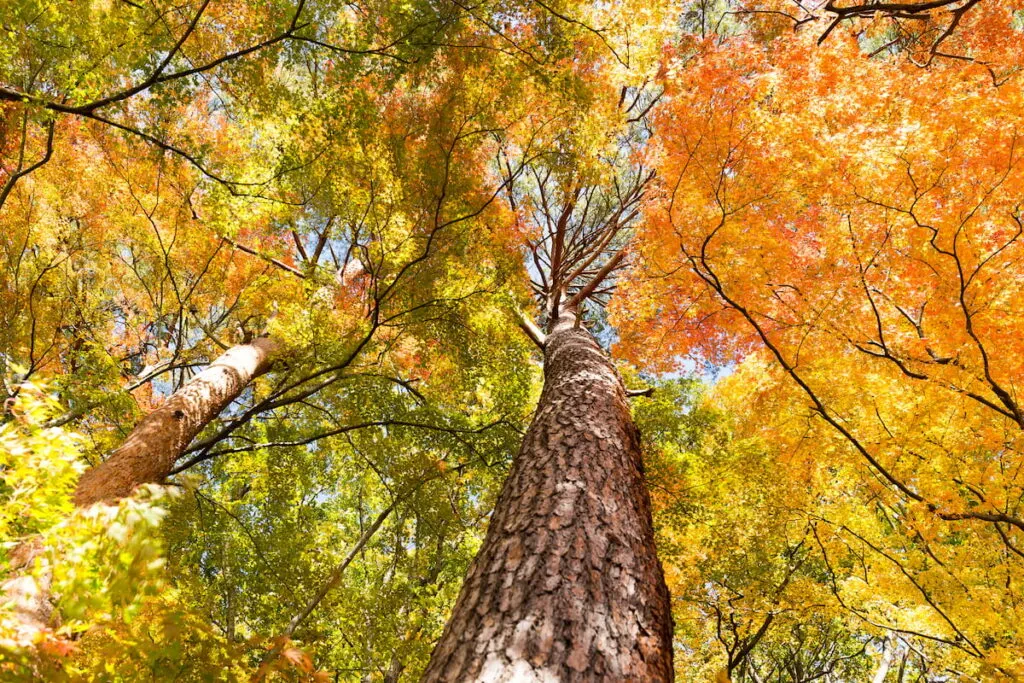
Maple tree species are distinguished by their palmate leaves, which have a finger-like appearance, and winged fruits. However, not all species have leaves of that type.
On average, maple trees reach 30 to 80 feet (9 to 25 m) tall. Meanwhile, the shrubs in the genus grow to only about 32 feet (10 m) with a few smaller trunks coming from the ground level. Typically, maple trees thrive in cooler temperatures.
They are found in USDA plant hardiness zones 4 through 9, with some species capable of tolerating the conditions in zone 3. The maple tree’s leaves turn different and beautiful colors in the autumn season. In Canada, the maple leaf is a national symbol representing peace, unity, and tolerance.
Because they are fast-growing trees with a high LAI, maple trees, particularly the red maple, are one of the trees that produce the most oxygen. In fact, in a year, a mature maple tree can produce oxygen for two people and absorb 48 pounds (21.77 kg) of carbon dioxide!
4. True Firs
True Firs, with a genus name Abies, which means “to rise,” are a genus of 48 to 56 species of evergreen coniferous trees that belong to the family Pinaceae. These trees are tall and large in the mountains of North and Central America, North Africa, Europe, and Asia, reaching 33 to 262 feet (10 to 80 m).
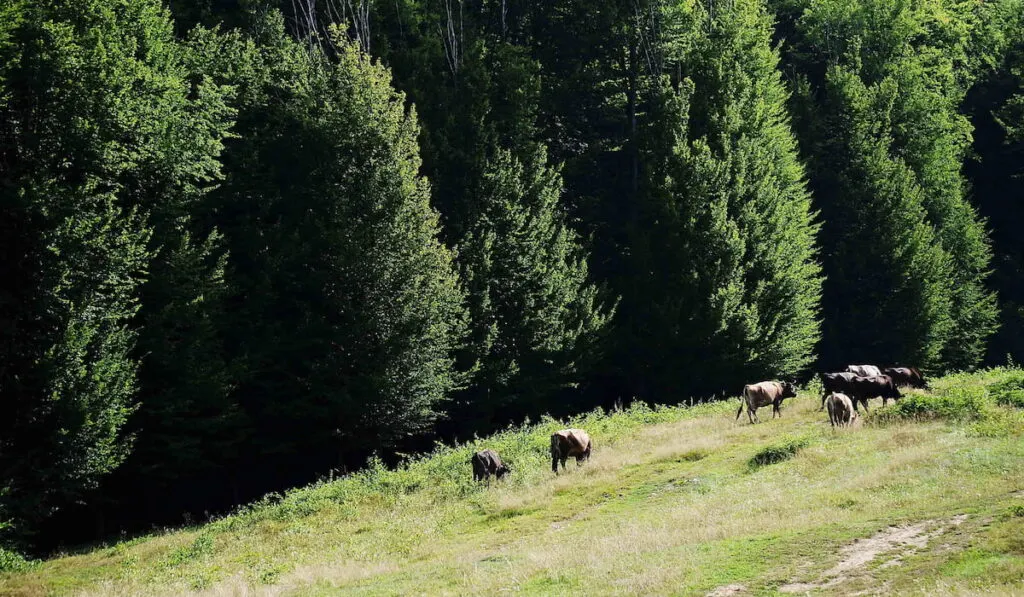
Firs have needle-like, flattened leaves, also called needles, that are about 1 inch (2.5 cm) long. The distinguishing feature of a true fir is how the needles attach to the twig through a concave structure on their base. Additionally, they have cones that, like those of real cedars, stand straight on the branches like candles and fall off as they reach maturity.
Some true Firs are used as live Christmas trees during the holiday season, such as the Balsam fir. The aromatic resin on younger branches give them their distinct aroma in the sun or when they are touched. Perfumes and pharmaceuticals are only some of the uses of Fir resins.
As evergreen trees, Firs produce plenty of oxygen. They are found in USDA plant hardiness zones 1 through 5.
5. Spruce
Spruces are large coniferous evergreen trees that belong to the genus Picea. Thirty-five different species of spruces grow both in the temperate zones of the northern and southern hemispheres. These trees vary in size, from 60 to 200 feet (20 to 60 m) tall. These trees thrive in USDA plant hardiness zones 3 through 7 and even up to zone 8 in the northwest.
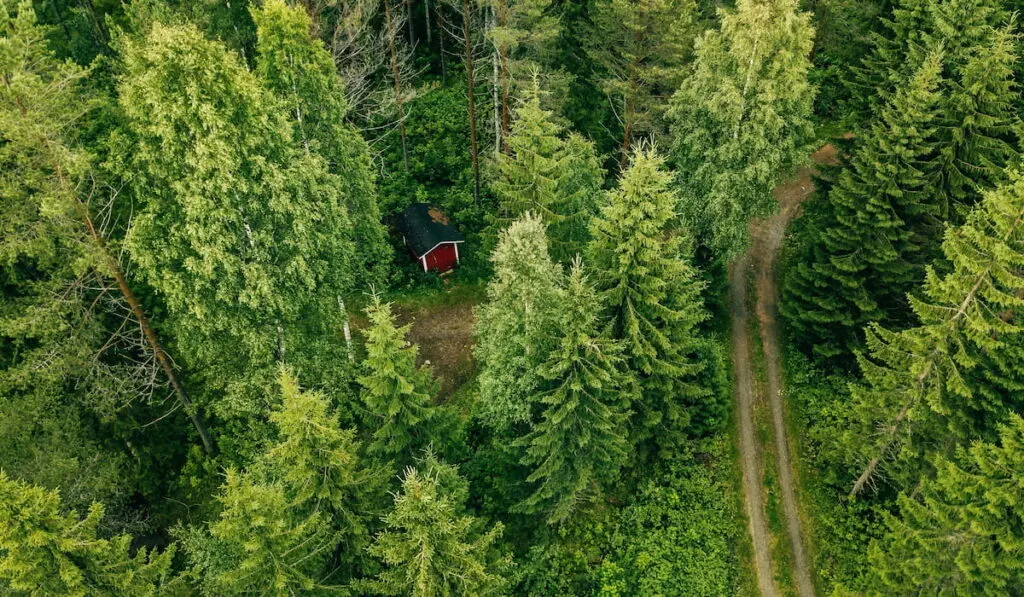
Spruces are distinguished from other trees of the pine family by three distinct features: they have needle-like leaves that are four-sided, the needles connect to the branches directly by a movable structure, and their cones change position to downward-facing after pollination. Like the Douglas Fir, the wood of Spruce trees is used as timber for construction.
Compared to Beech trees, Spruce trees have a lower Leaf Area Index (LAI). Despite this, they produce 58% more oxygen than Beech trees. This is because they are capable of photosynthesizing for around 260 days a year, versus Beech trees, which can do only about 176 days a year because they are deciduous. Because of this, Spruce trees are one of the trees that produce the most oxygen.
Factors That Affect the Oxygen Production of Trees
We now know the top five trees that produce the most oxygen. However, what factors affect the amount of oxygen a tree produces? Let’s go through those things one by one.
1. The Growth Rate of the Tree
The faster the tree grows, the more water and carbon dioxide it absorbs, thus producing more oxygen.
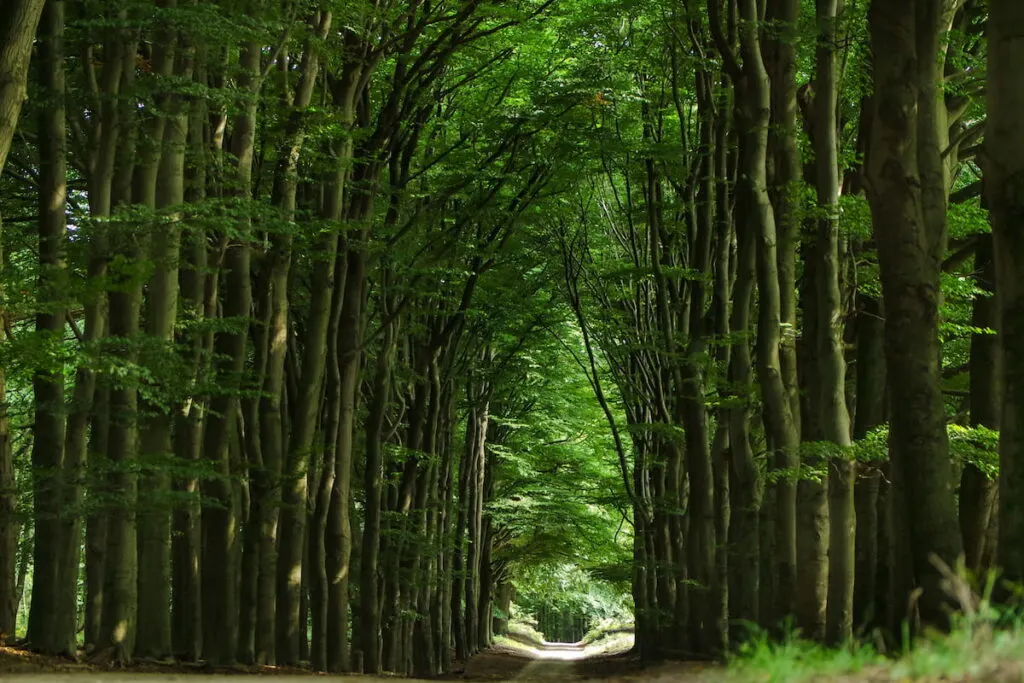
2. The Age of the Tree
Photosynthesis is a process that occurs on the leaf’s surface. Meanwhile, the total leaf area of a tree changes with its size and age. Taking these two things into consideration, it is concluded that the older the tree, the more oxygen it will produce because it has a more extensive leaf area.
In addition, the longer the tree’s lifespan, the longer it will produce and continue to release oxygen.
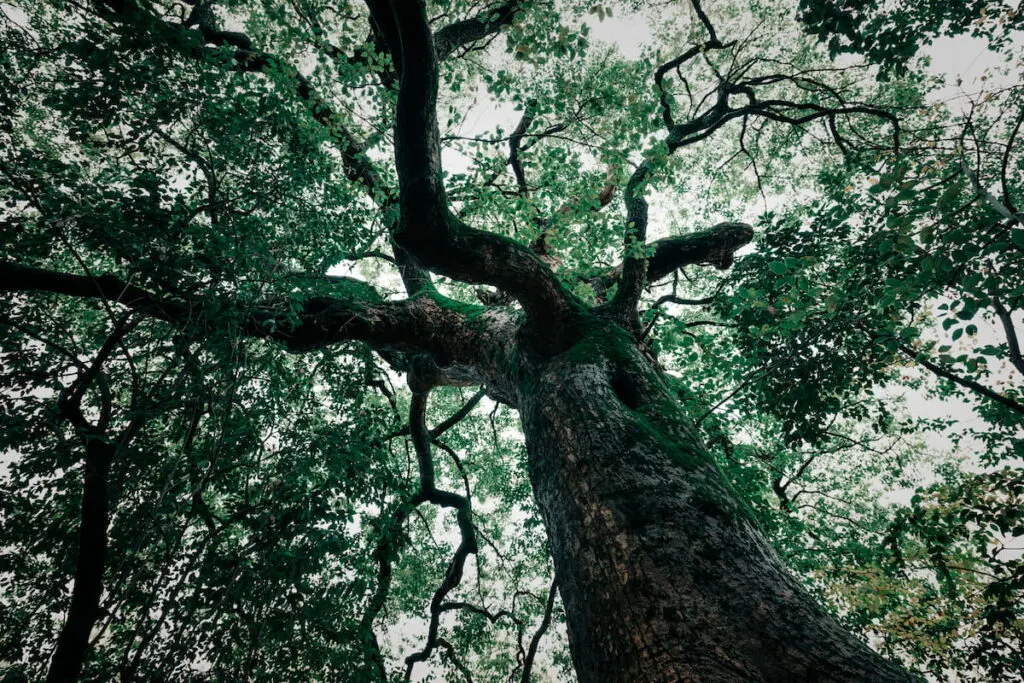
3. The Size of the Leaf
As mentioned, the amount of oxygen a tree produces depends on the light the leaves are exposed to. Leaf Area Index (LAI) measures the surface of the tree’s leaves per unit of land. In other words, the higher the tree’s Leaf Area Index (LAI), the more oxygen it will produce.
Do Trees Produce Oxygen at Night?
Trees do not produce oxygen at night since they need sunlight, water, and carbon dioxide to perform photosynthesis and make oxygen.

However, certain plants, such as cactus and succulents, use different ways to conduct photosynthesis, enabling them to release oxygen even at night. These plants depend on crassulacean acid metabolism (CAM) to keep their leaves’ stomata closed during the day, thus limiting the loss of water during hot weather. At night, the leaves’ stomata will open, allowing them to emit oxygen and absorb carbon dioxide.
Conclusion
In summary, leaves play a vital role in a tree’s oxygen production. Trees produce different amounts of oxygen depending on their Leaf Area Index. So, technically, trees cannot produce oxygen without leaves.
Therefore, in seasons where a tree loses its leaves, such as in autumn and winter, it will compensate by making plenty of excess oxygen in spring and summer when leaves are abundant.
Resources:
- https://untamedanimals.com/which-trees-produce-the-most-oxygen/
- https://sustainability-success.com/which-trees-produce-the-most-oxygen/
- https://gardentabs.com/how-hardy-are-maple-trees-are-and-which-zones-are-they-right-for/
- https://www.gardeningknowhow.com/ornamental/trees/beech/beech-trees-in-landscapes.htm
- https://www.gardeningknowhow.com/ornamental/trees/fir/douglas-fir-tree-care.htm
- https://www.thetreecenter.com/which-spruce-tree-should-i-plant/
